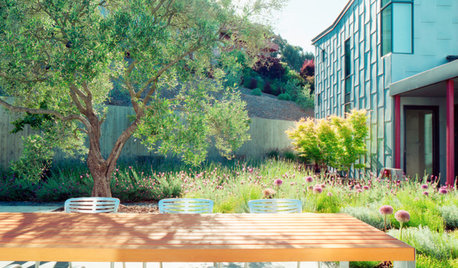suggestions sought for pruning young, struggling orchard
feijoas
11 years ago
Related Stories

EDIBLE GARDENSHow to Grow 10 Favorite Fruit Trees at Home
Plant a mini orchard in fall, winter or early spring to enjoy fresh-off-the-tree fruit the following year
Full Story
GARDENING GUIDESTop 12 Summer-Blooming Perennials for Deer-Resistant Drama
Can you have garden color, fragrance and exciting foliage with hungry deer afoot? These beauties say yes
Full Story
GARDENING FOR BUTTERFLIESGardening for the Bees, and Why It’s a Good Thing
When you discover how hard bees work for our food supply, you may never garden without them in mind again
Full Story
GARDENING GUIDESMake Sure You Read This Before Buying New Plants
Follow these 10 plant-selection tips to avoid buyer’s remorse
Full Story
FARM YOUR YARDIf You Have Room for Only One Fruit Tree ...
Juice up a small garden with one of these easier-care or worth-the-effort fruit trees for a mild climate
Full Story
FRUIT TREESHow to Grow Your Own Persimmons
Sturdy and easy to care for, these trees offer bright fruit through winter — and keeping them in bounds is no sweat
Full Story
LAWN ALTERNATIVESStop Fighting the Patchy Lawn!
Here are 3 situations where a garden may be a better idea than more turfgrass
Full Story
SMALL HOMESHouzz Tour: Thoughtful Design Works Its Magic in a Narrow London Home
Determination and small-space design maneuvers create a bright three-story home in London
Full Story
LANDSCAPE DESIGNGardening for Happy Kids
Foster creativity, self-esteem and more by designing your landscape with a sense of discovery
Full Story
LANDSCAPE DESIGNNative Plants Help You Find Your Garden Style
Imagine the garden of your dreams designed with plants indigenous to your region
Full StoryMore Discussions








alan haigh
alan haigh
Related Professionals
Fitchburg Landscape Architects & Landscape Designers · Middle Island Landscape Architects & Landscape Designers · Richmond Heights Landscape Architects & Landscape Designers · West Chester Landscape Architects & Landscape Designers · Woodinville Landscape Architects & Landscape Designers · Sahuarita Landscape Architects & Landscape Designers · Paradise Landscape Architects & Landscape Designers · Wilmington Landscape Contractors · Columbine Landscape Contractors · Englewood Landscape Contractors · Franklin Landscape Contractors · Medford Landscape Contractors · New Brighton Landscape Contractors · San Benito Landscape Contractors · Southbury Landscape ContractorsfeijoasOriginal Author
alan haigh
feijoasOriginal Author
alan haigh
alan haigh
feijoasOriginal Author